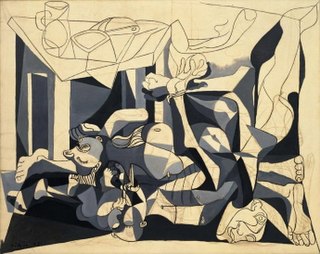
Georges Braque was a major 20th-century French painter, collagist, draughtsman, printmaker and sculptor. His most notable contributions were in his alliance with Fauvism from 1905, and the role he played in the development of Cubism. Braque's work between 1908 and 1912 is closely associated with that of his colleague Pablo Picasso. Their respective Cubist works were indistinguishable for many years, yet the quiet nature of Braque was partially eclipsed by the fame and notoriety of Picasso.

Lithography is a planographic method of printing originally based on the immiscibility of oil and water. The printing is from a stone or a metal plate with a smooth surface. It was invented in 1796 by the German author and actor Alois Senefelder and was initially used mostly for musical scores and maps. Lithography can be used to print text or images onto paper or other suitable material. A lithograph is something printed by lithography, but this term is only used for fine art prints and some other, mostly older, types of printed matter, not for those made by modern commercial lithography.

Pablo Ruiz Picasso was a Spanish painter, sculptor, printmaker, ceramicist, and theatre designer who spent most of his adult life in France. One of the most influential artists of the 20th century, he is known for co-founding the Cubist movement, the invention of constructed sculpture, the co-invention of collage, and for the wide variety of styles that he helped develop and explore. Among his most famous works are the proto-Cubist Les Demoiselles d'Avignon (1907) and the anti-war painting Guernica (1937), a dramatic portrayal of the bombing of Guernica by German and Italian air forces during the Spanish Civil War.

Guernica is a large 1937 oil painting by Spanish artist Pablo Picasso. It is one of his best-known works, regarded by many art critics as the most moving and powerful anti-war painting in history. It is exhibited in the Museo Reina Sofía in Madrid.

Théophile Alexandre Steinlen, was a Swiss-born French Art Nouveau painter and printmaker. He was politically engaged and collaborated with anarchist and socialist press.
Federico Castellón was a Spanish American painter, sculptor, printmaker, and illustrator of children's books.
Mourlot Studios was a commercial print shop founded in 1852 by the Mourlot family and located in Paris, France. It was also known as Imprimerie Mourlot, Mourlot Freres and Atelier Mourlot. Founded by Francois Mourlot, it started off producing wallpaper. Later, his son Jules Mourlot would expand the business to handle the production of chocolate labels for companies such as Chocolat Poulain, as well as ledgers, maps and stationery. Starting in the 1920s, Jules' son, Fernand Mourlot, converted one of the locations into a studio dedicated to printing fine art lithography.

Fernand Mourlot, son of Jules Mourlot, was the director of Mourlot Studios and founder of Editions Mourlot.

Aldo Crommelynck was a Belgian master printmaker who made intaglio prints in collaboration with many important European and American artists of the 20th century. At the time of his death, The Guardian termed Crommelynck the 'pre-eminent' and 'the most celebrated printmaker of the second half of the 20th century.'

The Charnel House is an unfinished 1944–1945 oil and charcoal on canvas painting by Spanish artist Pablo Picasso, which is purported to deal with the Nazi genocide of the Holocaust. The black and white 'grisaille' composition centres on a massed pile of corpses and was based primarily upon film and photographs of a slaughtered family during the Spanish Civil War. It is considered to be the second of three major anti-war Picassos, preceded by Guernica in 1937 and succeeded by Massacre in Korea in 1951. The painting is housed in the Museum of Modern Art in New York City.

The Lille Métropole Museum of Modern, Contemporary and Outsider Art (LaM), formerly known as Villeneuve d'Ascq Museum of Modern Art, is an art museum in Villeneuve d'Ascq, France.
Le petit picador jaune is an oil on wood painting by the Spanish artist Pablo Picasso, which he created in 1889 at the age of eight. It is considered to be the earliest known surviving work by the artist. The painting is a colourful representation of a Spanish bullfight, a subject which Picasso repeatedly returned to throughout his career.
Fernand-Louis Gottlob was a French graphic artist whose caricatures appeared in many humorous magazines.

The Vollard Suite is a set of 100 etchings in the neoclassical style by the Spanish artist Pablo Picasso, produced from 1930 to 1937. Named after the art dealer who commissioned them, Ambroise Vollard (1866–1939), the suite is in a number of museums. More than 300 sets were created.

Bull's Head is a found object artwork by Pablo Picasso, created in 1942 from the seat and handlebars of a bicycle. It is described by Roland Penrose as Picasso's most famous discovery, a simple yet "astonishingly complete" metamorphosis.
Toros Y Toreros is a 1961 book of bullfighting drawings by Pablo Picasso with text by bullfighter Luis Miguel Dominguin and an essay by Georges Boudaille. The title of the book is handwritten by Picasso.
Picasso. In the heart of darkness (1939–1945) was an exhibition presented October 5, 2019 through January 5, 2020, at the Musee de Grenoble. Presented with the help of the Musée Picasso, the Centre Pompidou, and the Kunstsammlung Nordrhein-Westfalen, it was the first exhibition in France featuring the creative process of Pablo Picasso during the Second World War.

Dove is a 1949 lithograph on paper created by Pablo Picasso in 1949 in an edition of 50+5. The lithograph displays a white dove on a black background, which is widely considered to be a symbol of peace. The image was used to illustrate a poster at the 1949 Paris Peace Congress and also became an iconographic image of the period, known as "The dove of peace". An example is housed in the collection of the Tate Gallery and MOMA. Since then, it has been considered a masterpiece.












